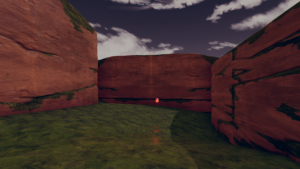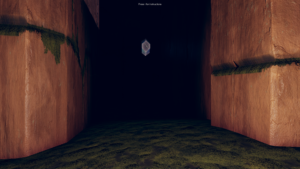The Maze is a 3D first-person game where the protagonist is lost in an island environment and must find a way out of three mazes to win. To create this game, I had to use the theme of disruption as inspiration: a situation where a disturbance or problem interrupts a process. The game went through several iterations before I found a way of successfully implementing the concept. Fortunately, I came up with the idea of transforming a one player game into a multiplayer one. In order to exit all three mazes, the player must find someone else to help move the character. There is no way in which one person alone can complete the game.

To implement the concept into the game I divided the job into two different tasks: designing the level and creating the digital and physical player interactions.
For designing the level, I used Unity’s 3D Game Kit to import game assets such as walls, gates, cliffs, and gems. I distributed these assets throughout the environment and created three mazes. The first maze has short walls and no dead ends. Its purpose is to let the players get acquainted with the controls. The second maze is larger in size, has taller walls, has less light, and has several dead ends. The players should already be familiar with the controls and should experience more of a challenge. The third and last maze is larger than the second, has taller walls, more dead ends, and absolutely no light. This is the most challenging game and its purpose is to bring more players to participate in the experience. In addition to the maze construction, I added some gems to indicate a correct direction within them, however, I did not add a clear path to follow because I wanted the players to have some difficulty. Since each maze is supposed to increase the difficulty of the game, the latter mazes have fewer gems in them.


For the digital player interactions, I wrote and assigned scripts to objects in Unity. The first person player model needed scripts for walking, rotating, and turning on a light. The gem model needed a script for changing color when interacting with the player to show that that path had already been walked through. The third maze needed a script for diming all lights when the player entered it. I also write a script that gave instructions to the player. I also added background music and footstep sounds.



For the physical multiplayer interactions, I used the Makey Makey kit to map physical inputs directly to the computer keyboard. I designed and laser cut two acrylic boxes that served as the buttons that could make a single player rotate left or right and two players to move forward. Nonetheless, I connected the circuits in such a way that two players would need to hold the buttons and hold hands at the same time to move forward. Additionally, I created a third acrylic circular piece that when touched would turn on a light. The inputs were placed at a far enough distance that a single player could not reach all of them, thus needing another player to win the game.

I believe I was able to meet my expectations and goals in the process of building the game. My initial idea was to create a game where the player would find himself or herself in an isolated environment. However, this idea had nothing related to the concept of disruption. I am very happy that I was able to find a way that I was able to use the concept to make an intended single-player isolated game into a collaborative and communicative multiplayer one. One cannot go through the game alone.
When playtesting the game, some players really took a while to understand the controls, but others got the hang of it pretty quickly. Overall though, they all understood that in order to succeed, they had to properly communicate: When should someone rotate? Which direction should one rotate to? When should someone press the button? How to move forward? How to press the light in the third maze when both hands are being used to move forward? Whether the players succeeded in going through all three mazes or just played the game for two minutes, I could see that everyone was laughing and having a good time. I received a lot of positive feedback with regards to the hand holding. Many enjoyed the connection and the communication needed with someone else to win the game.


I really enjoyed the fact that I was able to create a digital game that needed some sort of physical interaction between people to be beaten. I really like the idea of transforming a first-person player into something that many people can participate in. When I tried it for the first time, the entire class was holding hands. Everyone knew that if someone let go, the player would not move forward. That is why the idea of everyone contributing, even if a little bit, to the same objective, really engaged everyone.
I believe that the connections created out of disruption are the true meaning of the game.
File (Windows): https://drive.google.com/open?id=1rDM2Y4LHbAA1ETOugvj60xVkiw7X3W03
File (MAC): https://drive.google.com/file/d/19cpUaIBZDvTv9du48Ncej8adLBjPEmnX/view